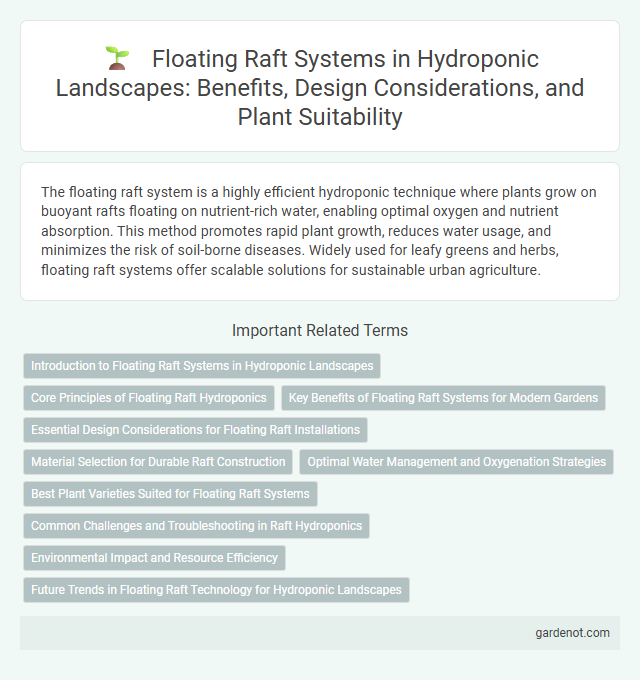The floating raft system is a highly efficient hydroponic technique where plants grow on buoyant rafts floating on nutrient-rich water, enabling optimal oxygen and nutrient absorption. This method promotes rapid plant growth, reduces water usage, and minimizes the risk of soil-borne diseases. Widely used for leafy greens and herbs, floating raft systems offer scalable solutions for sustainable urban agriculture.
Introduction to Floating Raft Systems in Hydroponic Landscapes
Floating raft systems in hydroponic landscapes utilize buoyant platforms to support plants grown in nutrient-rich water solutions, eliminating the need for soil. This method enhances oxygen availability to roots, promoting faster growth and higher yields in crops such as lettuce, herbs, and leafy greens. The system's efficiency and scalability make it ideal for both commercial operations and urban farming environments.
Core Principles of Floating Raft Hydroponics
Floating raft hydroponics operates on the principle of supporting plants on buoyant platforms that float atop nutrient-rich water, providing continuous access to oxygen and essential minerals. Root systems are suspended directly in the oxygenated nutrient solution, promoting rapid growth and efficient nutrient uptake. This system maximizes space utilization and water conservation while minimizing disease risks due to stagnant water.
Key Benefits of Floating Raft Systems for Modern Gardens
Floating raft systems enhance modern gardens by providing efficient nutrient delivery directly to plant roots, promoting faster growth and higher yields. These systems minimize water usage through recirculation, making them eco-friendly and cost-effective. Their ability to support diverse crops in compact spaces allows urban gardeners to maximize productivity without soil dependency.
Essential Design Considerations for Floating Raft Installations
Floating raft systems in hydroponic landscapes require essential design considerations including water depth, nutrient solution oxygenation, and plant spacing for optimal growth. Structural stability depends on appropriately sized rafts made from durable materials that support the weight of plants and water. Effective water circulation and disease prevention protocols are critical to maintain a healthy root environment and maximize crop yield.
Material Selection for Durable Raft Construction
High-density polyethylene (HDPE) is the preferred material for constructing floating rafts in hydroponic landscapes due to its excellent durability, resistance to UV rays, and lightweight nature. Expanded polystyrene foam provides buoyancy while maintaining structural integrity, ensuring the raft remains afloat under varying plant loads. Incorporating corrosion-resistant coatings on metal connectors enhances longevity by preventing rust and degradation in humid hydroponic environments.
Optimal Water Management and Oxygenation Strategies
The floating raft system in hydroponic landscapes maximizes crop yield through precise water level control and efficient nutrient delivery, ensuring optimal root hydration and minimal resource waste. Integrating aeration techniques such as air stones or oxygen diffusers enhances dissolved oxygen levels, promoting robust root respiration and preventing hypoxia. Regular monitoring of water parameters like pH, temperature, and dissolved oxygen concentration is critical for maintaining an ideal growth environment and preventing root diseases.
Best Plant Varieties Suited for Floating Raft Systems
Lettuce, spinach, and kale are among the best plant varieties suited for floating raft hydroponic systems due to their lightweight and fast growth characteristics. Herbs like basil, cilantro, and mint also thrive in these environments, benefiting from consistent nutrient delivery and oxygenation. Leafy greens dominate hydroponic floating rafts because they have shallow root systems optimal for water-based nutrient absorption.
Common Challenges and Troubleshooting in Raft Hydroponics
Common challenges in floating raft systems include nutrient film irregularities, oxygen depletion at the root zone, and algal growth on the raft surface. Troubleshooting involves monitoring dissolved oxygen levels, maintaining balanced nutrient solutions, and implementing physical or chemical controls to reduce algae proliferation. Proper system aeration, regular cleaning, and pH stabilization are essential for optimal plant growth and minimizing root diseases in raft hydroponics.
Environmental Impact and Resource Efficiency
The floating raft system in hydroponic landscapes significantly reduces water consumption by recirculating nutrient solutions, minimizing waste and promoting sustainable agriculture. This method also lowers the need for pesticides and herbicides, decreasing chemical runoff and its environmental footprint. Enhanced resource efficiency is achieved through precise nutrient delivery, leading to faster crop growth and reduced land use.
Future Trends in Floating Raft Technology for Hydroponic Landscapes
Emerging trends in floating raft technology for hydroponic landscapes emphasize the integration of IoT sensors and AI-driven nutrient management to optimize plant growth and resource efficiency. Advanced materials for rafts are being developed to enhance durability and biodegradability while reducing environmental impact. Modular and scalable designs allow for customizable setups that can adapt to various urban and commercial landscape applications, driving the future of sustainable hydroponics.
Floating raft system Infographic

 gardenot.com
gardenot.com